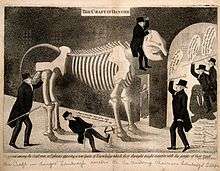John Barclay (anatomist)
John Barclay FRSE FRCPE FRCSE FLS MWS (10 December 1758 – 21 August 1826) was a Scottish comparative anatomist, extramural teacher in anatomy, and director of the Highland Society of Scotland.
.jpg)
.jpg)
Life
He was born in Cairn, Perthshire 10 December 1758,[1] the son of a farmer, and nephew of John Barclay, who established the Berean Church.
He was educated at Muthill parish school.
Barclay initially studied divinity at the University of St Andrews, and served as a minister. Then working as a family tutor, he educated himself in biological topics and anatomy. Pupils of his entered the University of Edinburgh in 1789, and Barclay became an assistant there to John Bell the anatomist, and was also associated with his brother Charles Bell. His employer Sir James Campbell financed the completion of his medical course.[2]
Barclay qualified M.D. at Edinburgh, before studying anatomy under Andrew Marshall for a year in London.[3] He returned to Edinburgh and established himself as an anatomical lecturer in 1797. Until 1825 he delivered two complete courses of human anatomy, a morning and an evening one, every winter session, and for several years before his death gave a summer course on comparative anatomy. His classes gradually grew in reputation; in 1804 he was formally recognised as a lecturer on anatomy and surgery by the Edinburgh College of Surgeons, and in 1806 he became a fellow of the Edinburgh College of Physicians.[2]
When a new chair of comparative anatomy for the University of Edinburgh was proposed in 1816, Barclay was the leading candidate. However, the proposal was defeated by the concerted opposition of a number of the incumbent medical professors, led by John Hope, Robert Jameson and Alexander Monro, tertius, who feared the new chair would encroach on their own prerogatives.[4] This episode provided the subject of a memorable caricature by John Kay.

Barclay supported his former pupil William Dick when he established his Dick Veterinary School.
For the final two years of his life Barclay was too ill to teach, during which his classes were carried on by Robert Knox, another former pupil.[2]
He died at Argyll Square in Edinburgh on 21 August 1826, and was buried in Restalrig Churchyard on the east side of the city.[1]
Works
Barclay contributed the article Physiology to the third edition of the Encyclopædia Britannica (1797). He developed ideas for a nomenclature of human anatomy based on scientific principles in A New Anatomical Nomenclature (1803). In 1808 he published a treatise on The Muscular Motions of the Human Body, arranged according to regions and systems, and with applications to surgery. This was followed in 1812 by his Description of the Arteries of the Human Body, the result of original study and dissection. A second edition appeared in 1820.[2]
He furnished descriptive matter to a series of plates illustrating the human skeleton and the skeletons of some animals, engraved by Edward Mitchell of Edinburgh in 1819–20.[5] Several of his lectures on anatomy were published posthumously in 1827. Another work was An Inquiry into the Opinions, Ancient and Modern, concerning Life and Organisation, published in 1822.[2] In this work Barclay gives a spirited defense of vitalism against a catalogue of thinkers he considered to be advocates of materialistic theories of life, including Erasmus Darwin, William Lawrence and Jean-Baptiste Fray. The noted Scottish zoologist and geologist John Fleming wrote that Concerning Life and Organization "should be perused with care by every student of Anatomy and Natural History, as an effective preservative against the doctrines of Materialism".[6]
He wrote Remarks on Mr. John Bell's Anatomy of the heart & arteries under the name "Jonathan Dawplucker, Esq."
Family
Barclay married Eleanora, daughter of his former employer Sir James Campbell of Aberuchill, in 1811.[2]
Legacy
Barclay gave his large collection of specimens to the Royal College of Surgeons of Edinburgh in 1821, under the condition that a suitable hall be built to display all the materials together, associated with his name.[7] In 1828 his collection became the Barcleian Museum.[8] It can now be seen at Surgeons' Hall.
Pupils
- Sir George Ballingall (1780 1855)
- William Dick (1793–1866).
- Dr Robert Knox (1791–1862)
- Robert Liston (1794–1847)
- Robert Nasmyth (1791-1870)
- James Syme (1799–1870)
- William Sharpey (1802-1880)
References
- http://www.royalsoced.org.uk/cms/files/fellows/biographical_index/fells_indexp1.pdf
- . Dictionary of National Biography. London: Smith, Elder & Co. 1885–1900.
- "John Barclay (1758–1826) extra-mural teacher of anatomy in Edinburgh: Honorary Fellow of the Royal College of Surgeons of Edinburgh". Royal College of Surgeons of Edinburgh and Royal College of Surgeons in Ireland. 2006. Retrieved 6 December 2010.
- Jacyna, Stephen (1994). Philosophic Whigs: Medicine, Science and Citizenship in Edinburgh, 1789-1848. London: Routledge. p. 82. ISBN 0415036143.
- Barclay, John; Mitchell, Edward (1824). A series of engravings representing the bones of the human skeleton : with the skeletons of some of the lower animals and explanatory references (Second ed.). Edinburgh: MacLachlan and Stewart.
- Fleming, John (1822). The Philosophy of Zoology; Or a General View of the Structure, Functions and Classification of Animals, Vol. 1. Edinburgh: Archibald Constable & Co. pp. xiii.
- Kaufman, Matthew H. (2003). Medical Teaching in Edinburgh during the 18th and 19th Centuries. Royal College of Surgeons of Edinburgh. pp. 77–78. ISBN 0-9503620-8-5.
- Sir William Jardine (1841). The naturalist's library. W. H. Lizars. p. 42. Retrieved 4 April 2012.
Further reading
- Chambers, Robert; Thomson, Thomas Napier (1857). . A Biographical Dictionary of Eminent Scotsmen. 1. Glasgow: Blackie and Son. pp. 147–149 – via Wikisource.
External links
| Wikimedia Commons has media related to John Barclay (anatomist). |
- Entry at the Gazetteer for Scotland
- Attribution
![]()